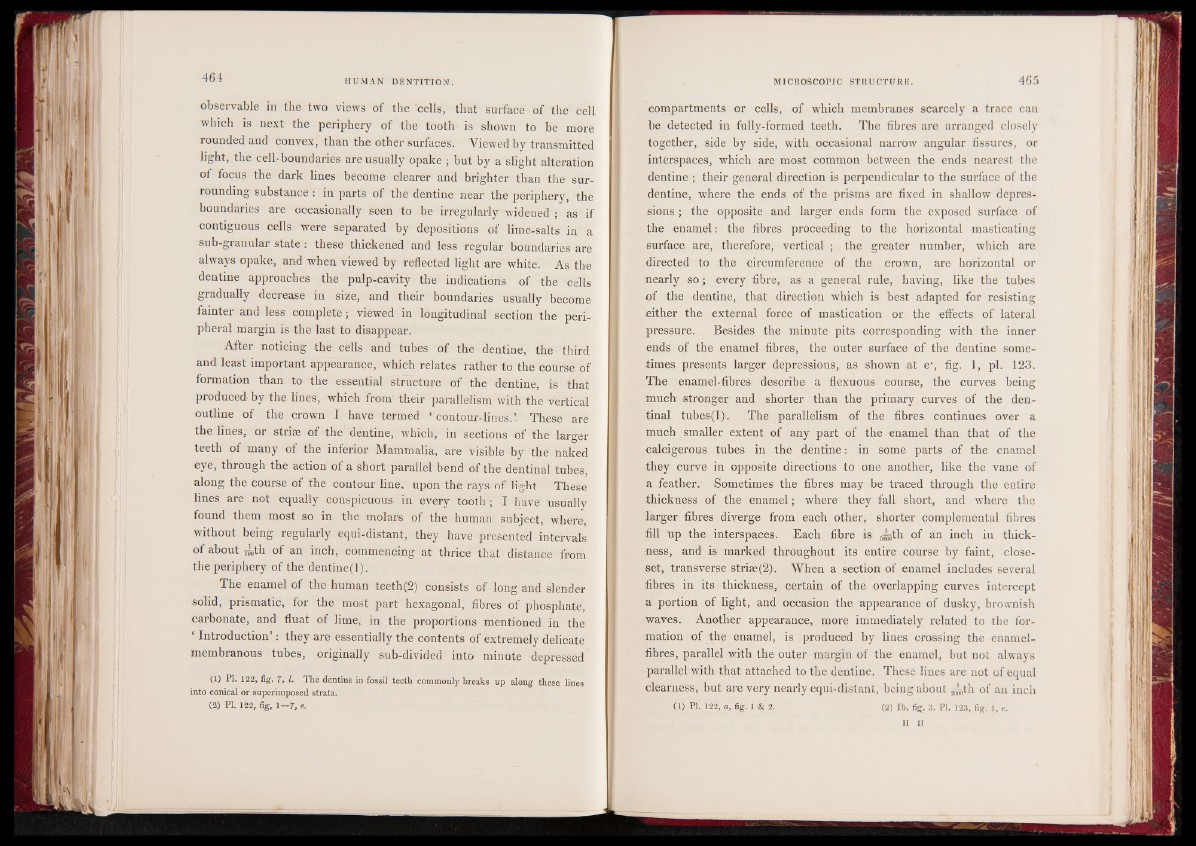
observable in the two views of the cells, that surface of the cell
which is next the periphery of the tooth is shown to be more
rounded and convex, than the other surfaces. Viewed by transmitted
light, the cell-boundaries are usually opake ; but by a slight alteration
of focus the dark lines become clearer and brighter than the surrounding
substance: in parts of the dentine near the periphery, the
boundaries are occasionally seen to be irregularly widened ; as if
contiguous cells were separated by depositions of lime-salts in a
sub-granular state : these thickened and less regular boundaries are
always opake, and when viewed by reflected light are white. As the
dentine approaches the pulp-cavity the indications of the cells
gradually decrease in size, and their boundaries usually become
fainter and less complete; viewed in longitudinal section the peripheral
margin is the last to disappear.
After noticing the cells and tubes of the dentine, the third
and least important appearance, which relates rather to the course of
formation than to the essential structure of the dentine, is that
produced by the lines, which from' their parallelism with the vertical
outline of the crown I have termed ‘ contour-lines.’. These are
the lines, or striae of the dentine, which, in sections of the larger
teeth of many of the inferior Mammalia, are visible by the naked
eye, through the action of a short parallel bend of the dentinal tubes,
along the course of the contour line, upon the rays of light. These
lines are not equally conspicuous in every tooth ; I have' usually
found them most so in the molars of the human subject, where,
without being regularly equi-distant, they have presented intervals
of about j®th of an inch, commencing at thrice that distance from
the periphery of the dentine(l).
The enamel of the human teeth(2) consists of long and slender
solid, prismatic, for the most part hexagonal, fibres of phosphate,
carbonate, and fluat of lime, in the proportions mentioned in the
‘ Introduction’: they are essentially the contents of extremely delicate
membranous tubes, originally sub-divided into minute depressed
(1) PI. 122, fig. 7, l. The dentine in fossil teeth commonly breaks up along these lines
into conical or superimposed strata.
(2) PI. 122, fig, 1—7, e.
compartments or cells, of which membranes scarcely a trace can
be detected in fully-formed teeth. The fibres are arranged closely
together, side by side, with occasional narrow angular fissures, or
interspaces, which are most common between the ends nearest the
dentine ; their general direction is perpendicular to the surface of the
dentine, where the ends of the prisms are fixed in shallow depressions
; the opposite and larger ends form the exposed surface of
the enamel: the fibres proceeding to the horizontal masticating
surface are, therefore, vertical ; the greater number, which are
directed to the circumference of the crown, are horizontal or
nearly so; every fibre, as a general rule, having, like the tubes
of the dentine, that direction which is best adapted for resisting
either the external force of mastication or the effects of lateral
pressure. Besides the minute pits corresponding with the inner
ends of the enamel fibres, the outer surfaee of the dentine sometimes
presents larger depressions, as shown at e‘, fig. 1, pi. 123.
The enamel-fibres describe a flexuous course, the curves being
much stronger and shorter than the primary curves of the dentinal
tubes{I). The parallelism of the fibres continues over a
much smaller extent of any part of the enamel than that of the
calcigerous tubes in the dentine: in some parts of the enamel
they curve in opposite directions to one another, like the vane of
a feather. Sometimes the fibres may be traced through the entire
thickness of the enamel; where they fall short, and where the
larger fibres diverge from each other, shorter complemental fibres
fill up the interspaces. Each fibre is j^th of an inch in thickness,
and is marked throughout its entire course by faint, close-
set, transverse striae, (2). When a section of enamel includes several
fibres in its thickness, certain of the overlapping curves intercept
a portion of light, and occasion the appearance of dusky, brownish
waves. Another appearance, more immediately related to the formation
of the enamel, is produced by lines crossing the enamel-
fibres, parallel with the outer margin of the enamel, but not always
parallel with that attached to the dentine. These lines are not of equal
clearness, but are very nearly equi-distant, being about ^ th of an inch
(1) PI. 122, a, fig. 1 & 2. (2) lb. fig. 3. PI. 123, fig. I, e.
H H